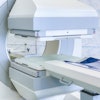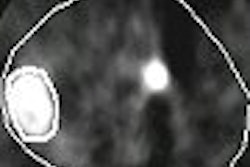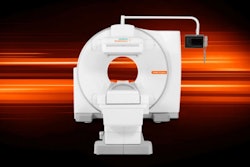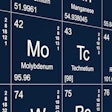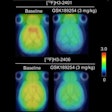
Just as it appeared ready to enter the clinical mainstream, PET imaging has been thrown a series of setbacks that raise questions as to whether it will ever live to up its potential. In this article, PET educator Dr. Richard Black discusses PET's spectacular rise, and also the threats that may bring it back to earth. For purposes of brevity, "PET" is taken to refer to both standalone PET and PET/CT.
Just less than a year ago, PET scanning with fluorine-18-labeled glucose was the hottest topic in medical imaging. PET had always excelled in metabolic imaging, but the addition of hybrid CT created PET/CT, adding a new anatomical wrinkle that made a good thing even better.
Like many new medical imaging technologies, PET's fortunes have risen and fallen based on reimbursement. A coordinated effort by many dedicated physicians was able to convince the U.S. Centers for Medicare and Medicaid Services (CMS) to approve the use of PET with FDG for the evaluation of a significant number of oncologic diseases, in applications including diagnosis, staging, and therapy tracking.
Things began to change in late 2005, however, with passage of the Deficit Reduction Act of 2005. While the intricacies of this legislation are beyond the scope of this article, it in effect reduced reimbursement for FDG-PET procedures by 50%, eliminating what had been a healthy financial incentive to own and operate a PET business. In 2007, this level of reimbursement is now considered to be inadequate to justify the expense of purchasing a PET/CT scanner.
The previously high hopes for PET now lie in shambles, with the market for PET systems in the U.S. nearly collapsing in the face of massive reimbursement cuts. Those facilities with PET and PET/CT units already in place (a number estimated at over 700 sites in the U.S.) limp along with patient volumes that are a shadow of former projections.
With PET under siege and scanner sales dropping, imaging vendors are showing signs of losing interest in what had been imaging's glamour modality. Many are focusing attention on hybrid anatomic/metabolic imaging using more economical modalities, such as SPECT/CT.
Will PET be able to recover from these threats? Or is the technology an endangered species, doomed to extinction? This article will address the rise and fall of PET, and will suggest a possible future in which PET is able to recover and even thrive despite an unfriendly economic environment.
The value of glucose imaging
PET's strength is its ability to take advantage of the remarkable biochemistry of glucose and its scientifically proven and well-understood relationship to cancer cell growth, replication, and viability. Coupling the biochemical exploitation of this known metabolite to the superior resolution of multidetector PET systems, especially when paired with an anatomic modality like CT or (someday soon) MRI, provides unparalleled insight into the cancerous condition and the extraordinary ability to define the state of disease prior to, during, and after treatment.
For example, in January 2001, Gambhir and associates demonstrated the power of PET in evaluating oncological disease with an analysis of virtually every publication through the year 2000. In more than 13,000 patients studied with both dedicated PET and anatomical imaging (CT or MRI) with various neoplasms, the median sensitivity for detecting malignant disease was 88% for dedicated PET compared to 71% for CT or MRI examinations. PET's median specificity showed similar trends with a recorded value of 89% for PET and 70% for CT or MRI. This clearly demonstrates PET's superior detection and characterization of malignant disease compared to conventional imaging procedures. (Journal of Nuclear Medicine, 2001, Vol. 42: 90050, pp. 1S-93S).
Hundreds of articles have demonstrated the superiority of PET imaging, even in exhaustive meta-analyses. One such example showed a clear advantage for PET in evaluating mediastinal metastases in patients with biopsy-proven lung cancer. In 32 studies consisting of 1,959 patients, FDG-PET demonstrated a sensitivity and specificity of 85% and 90%, respectively. This compares to data from 23 studies using CT in 1,119 patients, in which mean sensitivity and specificity of 61% and 79% were recorded. (Annals of Internal Medicine, December 2003, Vol. 139:11, pp. 879-892).
This is but a small insight into the vast capability of molecular imaging with FDG-PET when compared to anatomic imaging studies. Similar data exist for evaluating patients during therapy to predict outcome, as well as for detecting recurrent neoplastic disease. Any expenditure of time reviewing the peer-reviewed literature will demonstrate the superior capabilities of PET, and demonstrate that PET, if given the chance, has the ability to be a first-line imaging modality, in place of the anatomic technologies that have been radiology's workhorses for so long.
Living up to its potential
So, with such a powerful piece of ammunition to do battle with a most unpopular enemy (neoplastic disease), why has this revolutionary capability not seen more widespread acceptance and impact?
Let us take a look back a few years to gain an understanding of what the developing PET market was predicted to achieve and what has actually materialized.
Shortly after CMS approved Medicare reimbursement for the utilization of PET imaging in a variety of malignant diseases in January 2001, the industry projected robust PET utilization, which would lead to the purchase of PET scanners for placement in both hospitals and outpatient imaging centers.
According to one presentation from a PET symposium in November of 2002, calendar 2005 would see more than 4 million PET studies conducted in the U.S. for the purposes of diagnosis and 7 million studies for the assessment of therapy in patients with cancer (Manning, PET Symposia CTI presentation, November 2002, Las Vegas).
Three years later, PET utilization in the U.S. had reached just over 1 million PET studies, according to a report analyzing 2005 and 2006 by market research firm IMV Medical Information Division of Des Plaines, IL. This fell far short of earlier projections.
Viewing the situation from a different perspective, the number of CT examinations performed annually in the U.S. for evaluating patients with neoplastic disease approached 20 million in about the same timeframe, according to a researcher report published in May 2004 by Marketing Relevance. This puts the utilization of PET at about 5% of that of CT.
These numbers raise the question: If PET had only achieved a 5% utilization rate compared with CT when the reimbursement environment was favorable, how bad are things going to get now that the reimbursement situation is so much worse?
The value of education
It can be easy to blame economic conditions for PET's current predicament, but another culprit is to blame -- inadequate education on PET's value on the part of both referring physicians and radiologists. If the education problem could be addressed effectively, PET could begin to grow again and thrive in spite of today's adverse economic environment.
PET's value derives from its ability to produce images that are radically different from those generated by anatomic modalities. But this quality also makes PET images much more difficult to interpret for radiologists with anatomy-based educations, and also more difficult to order for referring physicians who are unaware of the technology's value.
The obvious solution is education, but at present our efforts have been woefully inadequate. Some well-intentioned individuals through various educational efforts have attempted to bridge the gap, but due to time constraints and demands of either academic or private community-based medical practice, comprehensive assimilation of the data supporting PET's value has not occurred.
Rather, what is available is limited to cursory reviews of the capabilities of FDG-PET or textbooks that are not widely utilized by the referring physicians for edification in a field in which they are not direct participants. There is a perceived and real deficit in the training of physicians to become aware of this modality, either as readers during their residency, which normally entails engaging in the mastery of CT, MRI, and anatomic modalities, or in the referring physician population, where there is minimal exposure to PET imaging in the care and management of patients with cancer.
Our formal education system is also falling short. At this point, a bewildering disparity (greater than 400:1) exists between the number of residents in diagnostic radiology programs and individuals training for expertise in nuclear medicine, according to figures from the Accreditation Council for Graduate Medical Education (ACGME). Most diagnostic radiology residents and thereafter attending physicians concentrate and focus on anatomically oriented applications of imaging to include CT, MR, mammography, and ultrasound, or invasive diagnostic procedures, in addition to therapeutic endeavors.
Radiologists not trained in PET during their residencies will likely have little interest in interpreting PET images due to their lack of familiarity with the procedure. Definitive guidelines exist for the number of CT or MR images that must be interpreted to qualify for board-certification examinations and maintain the accreditation of the residency training program.
Very few training programs offer intensive experience with PET imaging, so radiology professionals are left on their own to get training, which could be as brief as a three-day course or a five-day visit to an academic center. This produces an obvious disparity in the confidence of readers who may have read thousands of CT images during their residency, but only perhaps 50 to 100 cases of PET in a typical imaging course.
Real-world examples
I'm convinced that PET can succeed even if reimbursement does not change. Indeed, there are numerous examples of imaging technologies that have faced similar economic challenges, but that have survived and even thrived thanks to the efforts of dedicated proponents.
For example, mobile MRI transitioned to fixed-site MRI due to its being an anatomically based procedure in line with CT and the adequate training of diagnostic radiology residents to understand the procedure and deliver effective objective information to the requesting physician. Unfortunately, it appears that this same approach has not been undertaken when it comes to PET imaging.
PET's success in the mobile realm provides a hint at strategies that might work. Considering that there is typically a five-day workweek, if five patients are studied with PET once a week at a single facility, and we assume for the purposes of argument that the utilization rate of PET is currently 10% of what it should be, then a total of 50 patients should be candidates for PET procedures for that five-day workweek.
This would facilitate the mobile business and produce the need for more coaches. The logical progression would then be the placement of a fixed-site scanner. This can only be achieved with comprehensive educational efforts to boost the confidence of the reading physician and improve the accuracy of reports, and by increasing the demand for studies by educating the referring physician population.
Good education works for referring physicians. Like most radiology imaging physicians, they are not trained in the capabilities of PET imaging in oncology during residency or fellowship, but will respond when they receive high-quality educational materials regarding PET's value.
For example, a PET/CT site in the southwestern U.S. recently conducted a CME seminar via the Web to referring physicians at three facilities to educate them as to the validity of PET imaging. Previously the site had performed only 114 studies over a six-month period, despite rather intensive standard marketing efforts. Following the event, the PET/CT facility's procedure volume grew to 362 studies over the next six-month period, an increase of approximately 300%.
With proper education leading to increased demand, the current Medicare reimbursement of about $1,100 per PET procedure would justify the acquisition of a new PET/CT system. A valid comparison can be made to 3-tesla MRI magnets: a typical 3-tesla MRI unit costs upward of $2.5 million, compared to $1.3 million to $2 million for a PET/CT scanner, depending on configuration. The MRI scanner is capable of producing revenue about equivalent to that of a PET/CT scanner (two MRI scans per hour at an average reimbursement of about $500 per scan). This calculation indicates that PET/CT can still be profitable for imaging facilities. But most important, patients would be deriving the benefit of PET technology.
Moving forward
These examples indicate that while PET may be an endangered species, its extinction is not a foregone conclusion. What is needed desperately at this time is a widespread educational effort. This must be comprehensive, with data from the literature to prove the capability of PET in various clinical scenarios. This unequivocally needs to extend beyond the reprinted manuscript or the six-paragraph synopsis of the technology in a specific disease, and case presentations consisting of patient paradigm and testimonials, which in essence amounts to a picture show of sorts, to demonstrate how the procedure works.
Who will benefit the most from such an educational effort? The answer is quite easy -- the patient will benefit. Who stands to lose if this technology continues in a hover pattern at 10% of its potential utilization, or worse yet, a decline due to misunderstanding and lack of acceptance? Obviously, once again, it is the patient that stands to lose the most.
PET was in effect dropped into the mainstream of medicine, and medicine was expected to assimilate PET into the mechanisms of medical practice. However, the complexity level of this powerful tool has precluded its acceptance.
PET should not be allowed to remain a minor contributor to management of patients with malignant disease. Rather, it is time to engage the learning curve of PET and fulfill the responsibility that has been uniquely given to the imaging community, which is the care of patients with life-threatening disease. This will require both the will and desire to put forth the effort to fully comprehend this modality and its contributions to patient care. Not only does comprehensive education need to be made available, but more importantly it must be embraced by members of both the referring physician and imaging professional communities alike.
By Dr. Richard Black
AuntMinnie.com contributing editor
August 3, 2007
Dr. Black has interpreted more than 40,000 PET studies and is the creator of Nuclear Medicine Review, a 4,000-page database on PET and nuclear medicine literature with other 60,000 references. He is an interpreting nuclear medicine physician for various clients throughout the U.S., including Franklin & Seidelmann Subspecialty Radiology of Beachwood, OH.
Disclosure notice: AuntMinnie.com is owned by IMV, Ltd.
Related Reading
PET scans useful in identifying colorectal cancer recurrence, July 9, 2007
CMS reconsiders coverage for new PET uses, June 26, 2007
FDG uptake correlates with survival, biomarkers in NSCLC, June 19, 2007
First PET/MRI brain images debut at SNM 2007, June 15, 2007
PEM performs well against breast MRI, whole-body PET, June 6, 2007
Copyright © 2007 AuntMinnie.com

